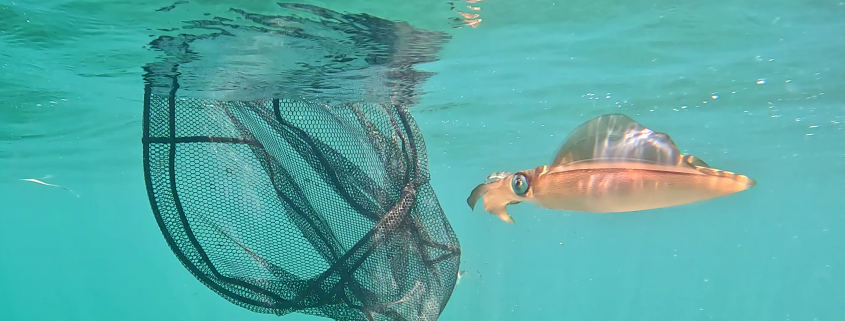Studying the sizes, seasons and whereabouts of Cockburn Sound’s squid
Innovative research in Cockburn Sound is looking at the distribution, abundance and seasonal habits of squid – a popular catch for recreational fishers.
The project is part of the WAMSI Westport Marine Science Program and designed to better understand the population of squid in the area. It is one of the first projects in Australia to try to determine localised habits of southern calamari – the main squid species in Cockburn Sound.
Dr Daniel Yeoh from the Department of Primary Industries and Regional Development, who is part of the research team, said scientists had been doing monthly sampling at up to 30 sites from Fremantle to Rockingham.
“We are looking at which areas of the Sound are most important to squid, including specific habitats and depth,” Dr Yeoh said.
“Certain habitats like seagrass generally have higher catch rates than bare sand.”
He said the exact location and depth of every squid caught was recorded using a GPS. Squid were then quickly measured and their sex noted before being released. A range of environmental parameters were recorded on each sampling occasion, including temperature, water clarity, weather and sea conditions.
“Scientists are finding out what factors influence the distribution and abundance of squid and how this is affected by environmental conditions such as temperature and water clarity. A range of biological information has also been gathered to improve the understanding of squid life cycles in Cockburn Sound,” Dr Yeoh said.
The sites selected for sampling ranged in depth from two to 15 metres and contained areas with dense seagrass meadows, areas with sparse seagrass coverage, and sandy areas with little or no vegetative cover.
“Studies in the eastern states have shown certain species of seagrass are more important for breeding and squid to lay their eggs on, so not all seagrass is the same.”
He said the research was ongoing but there were seasonal trends emerging.
“We started this research in August 2021 and the catches were moderate and then they declined in spring and summer. By the next autumn, catch rates increased.”
“Squid have a very short life cycle and only live for about one year. Their peak spawning is during spring when the large adult squid lay eggs and then die-off.
“Over summer the young squid grow and by the following autumn they reach a size where they can be caught, so catches increase.”
Dr Yeoh said most of the squid caught by the researchers were released but they were initially kept in holding tanks on the research vessels.
“Because we don’t want to catch the same squid twice, we put them in an aerated holding tank and we have found they release well. They don’t tend to release well if they’re kept in a bucket.”

